HIV Transmission via Blood Transfusion: A Case Study Analysis
VerifiedAdded on 2022/08/19
|13
|1211
|7
Report
AI Summary
This report delves into the critical issue of HIV transmission through blood transfusions, a topic of significant public health concern. It begins by defining blood transfusions and their benefits, as well as the potential adverse reactions that can occur. The report then provides a comprehensive overview of HIV, its transmission methods, and its devastating impact on the immune system. A central focus of the report is the relationship between HIV and blood transfusions, emphasizing the risk of transmission if blood is not properly screened. A poignant case study illustrates the tragic consequences of contracting HIV through a blood transfusion, highlighting the social stigma and personal devastation. The report concludes by outlining crucial steps to reduce the risk of HIV transmission, including raising awareness, implementing effective screening measures, and ensuring the use of sterile equipment. The provided references support the information and recommendations, offering valuable insights into the importance of safe blood transfusion practices and HIV prevention.
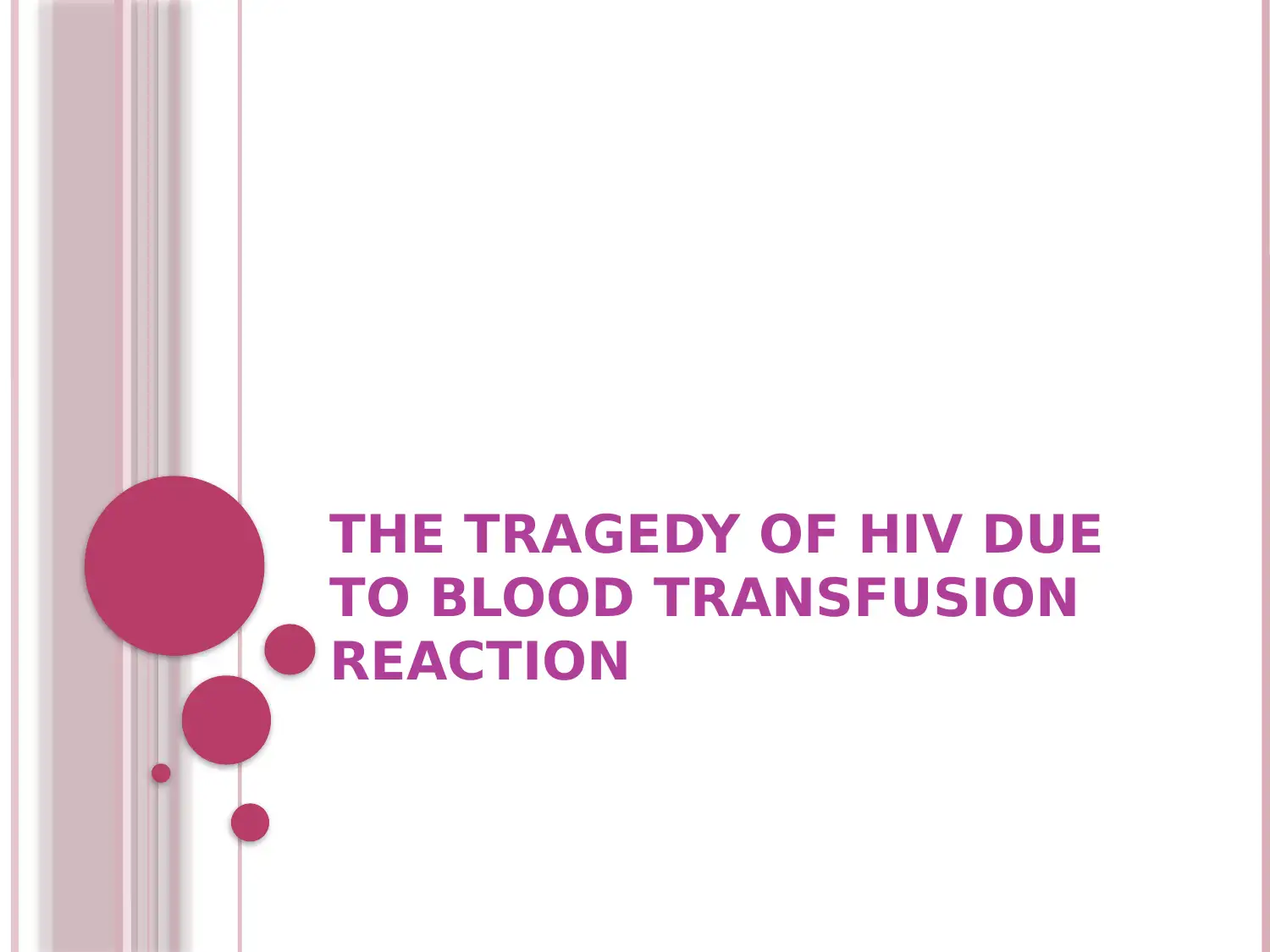
THE TRAGEDY OF HIV DUE
TO BLOOD TRANSFUSION
REACTION
TO BLOOD TRANSFUSION
REACTION
Paraphrase This Document
Need a fresh take? Get an instant paraphrase of this document with our AI Paraphraser
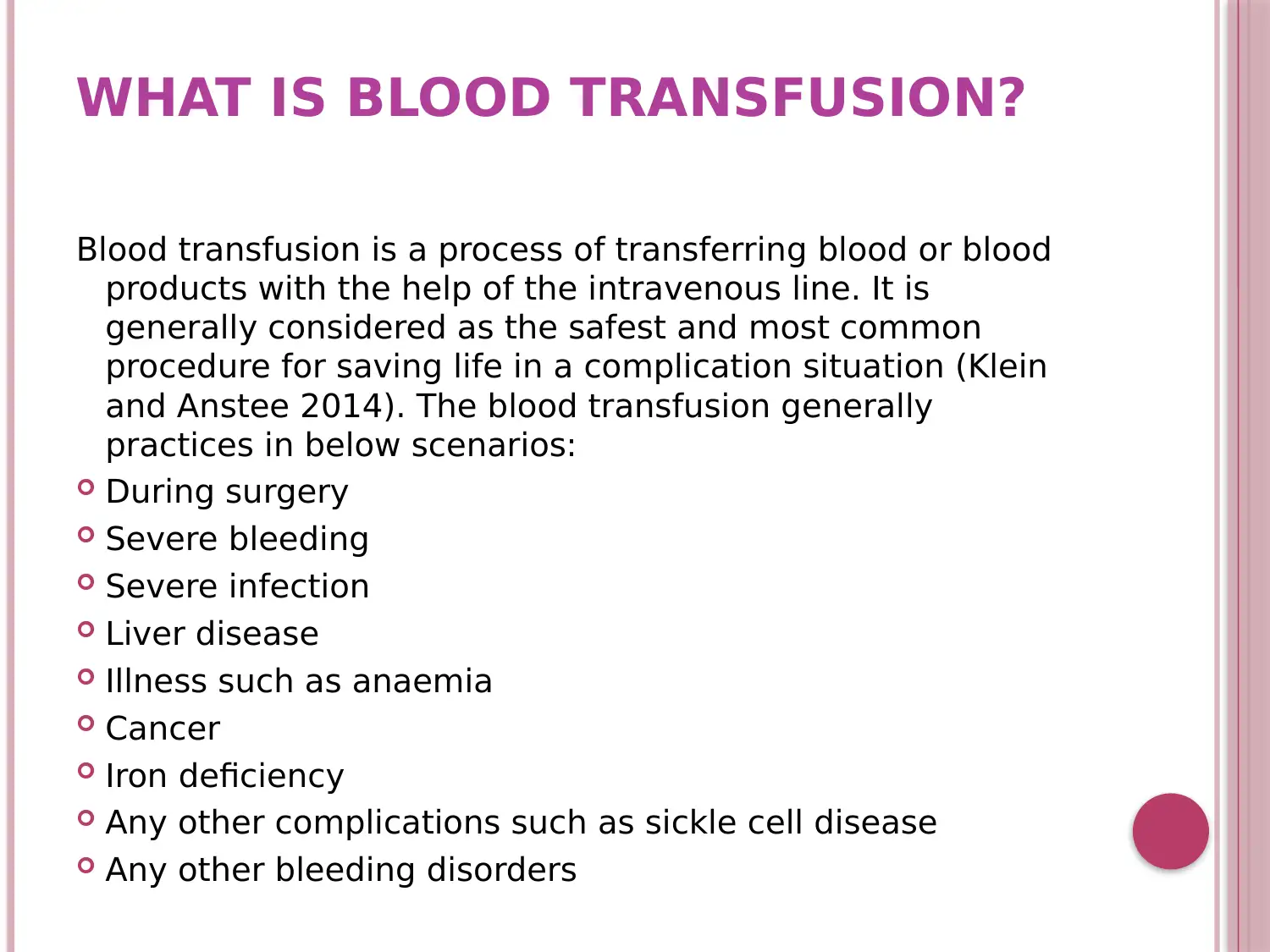
WHAT IS BLOOD TRANSFUSION?
Blood transfusion is a process of transferring blood or blood
products with the help of the intravenous line. It is
generally considered as the safest and most common
procedure for saving life in a complication situation (Klein
and Anstee 2014). The blood transfusion generally
practices in below scenarios:
During surgery
Severe bleeding
Severe infection
Liver disease
Illness such as anaemia
Cancer
Iron deficiency
Any other complications such as sickle cell disease
Any other bleeding disorders
Blood transfusion is a process of transferring blood or blood
products with the help of the intravenous line. It is
generally considered as the safest and most common
procedure for saving life in a complication situation (Klein
and Anstee 2014). The blood transfusion generally
practices in below scenarios:
During surgery
Severe bleeding
Severe infection
Liver disease
Illness such as anaemia
Cancer
Iron deficiency
Any other complications such as sickle cell disease
Any other bleeding disorders
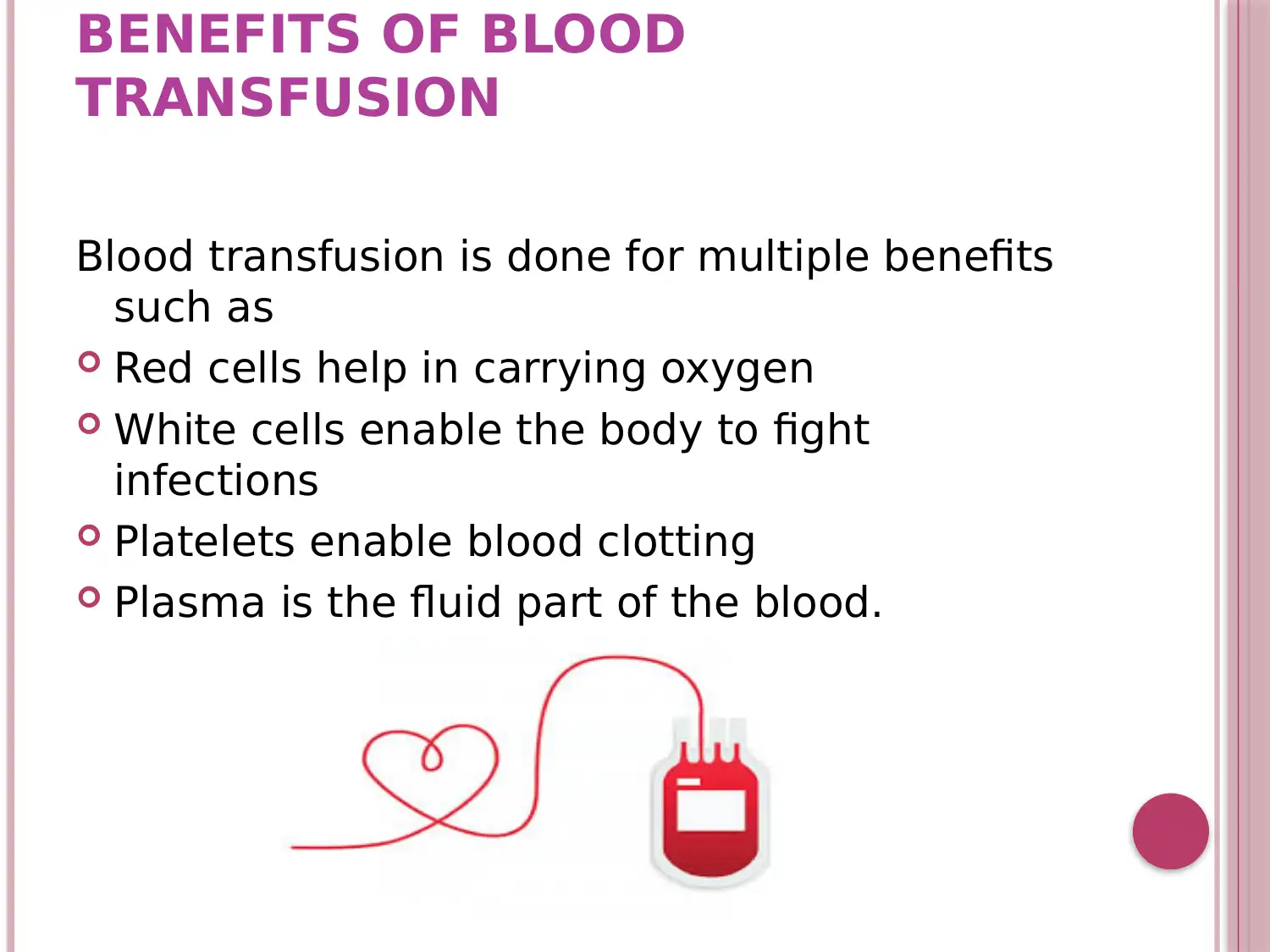
BENEFITS OF BLOOD
TRANSFUSION
Blood transfusion is done for multiple benefits
such as
Red cells help in carrying oxygen
White cells enable the body to fight
infections
Platelets enable blood clotting
Plasma is the fluid part of the blood.
TRANSFUSION
Blood transfusion is done for multiple benefits
such as
Red cells help in carrying oxygen
White cells enable the body to fight
infections
Platelets enable blood clotting
Plasma is the fluid part of the blood.
⊘ This is a preview!⊘
Do you want full access?
Subscribe today to unlock all pages.

Trusted by 1+ million students worldwide
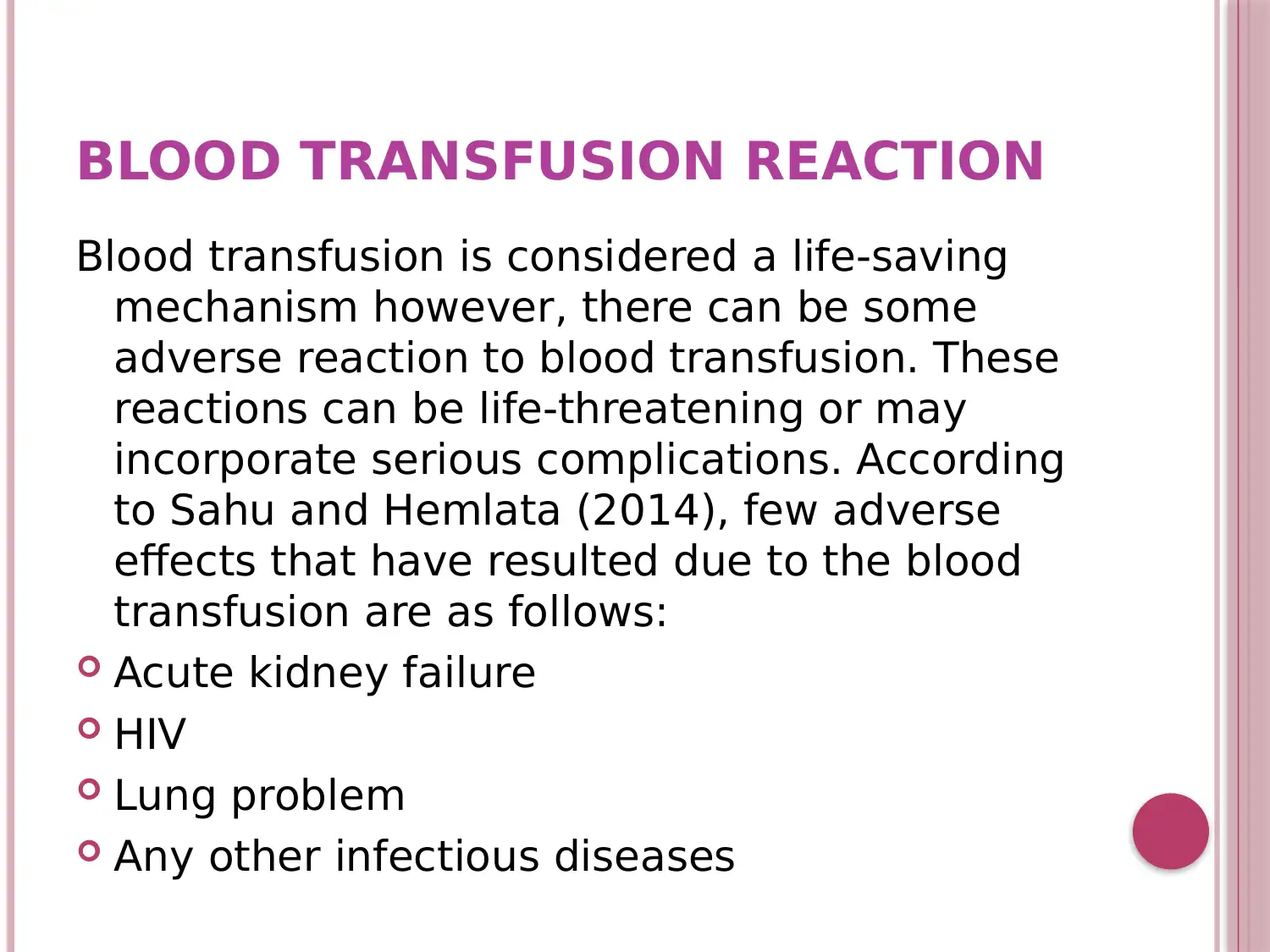
BLOOD TRANSFUSION REACTION
Blood transfusion is considered a life-saving
mechanism however, there can be some
adverse reaction to blood transfusion. These
reactions can be life-threatening or may
incorporate serious complications. According
to Sahu and Hemlata (2014), few adverse
effects that have resulted due to the blood
transfusion are as follows:
Acute kidney failure
HIV
Lung problem
Any other infectious diseases
Blood transfusion is considered a life-saving
mechanism however, there can be some
adverse reaction to blood transfusion. These
reactions can be life-threatening or may
incorporate serious complications. According
to Sahu and Hemlata (2014), few adverse
effects that have resulted due to the blood
transfusion are as follows:
Acute kidney failure
HIV
Lung problem
Any other infectious diseases
Paraphrase This Document
Need a fresh take? Get an instant paraphrase of this document with our AI Paraphraser
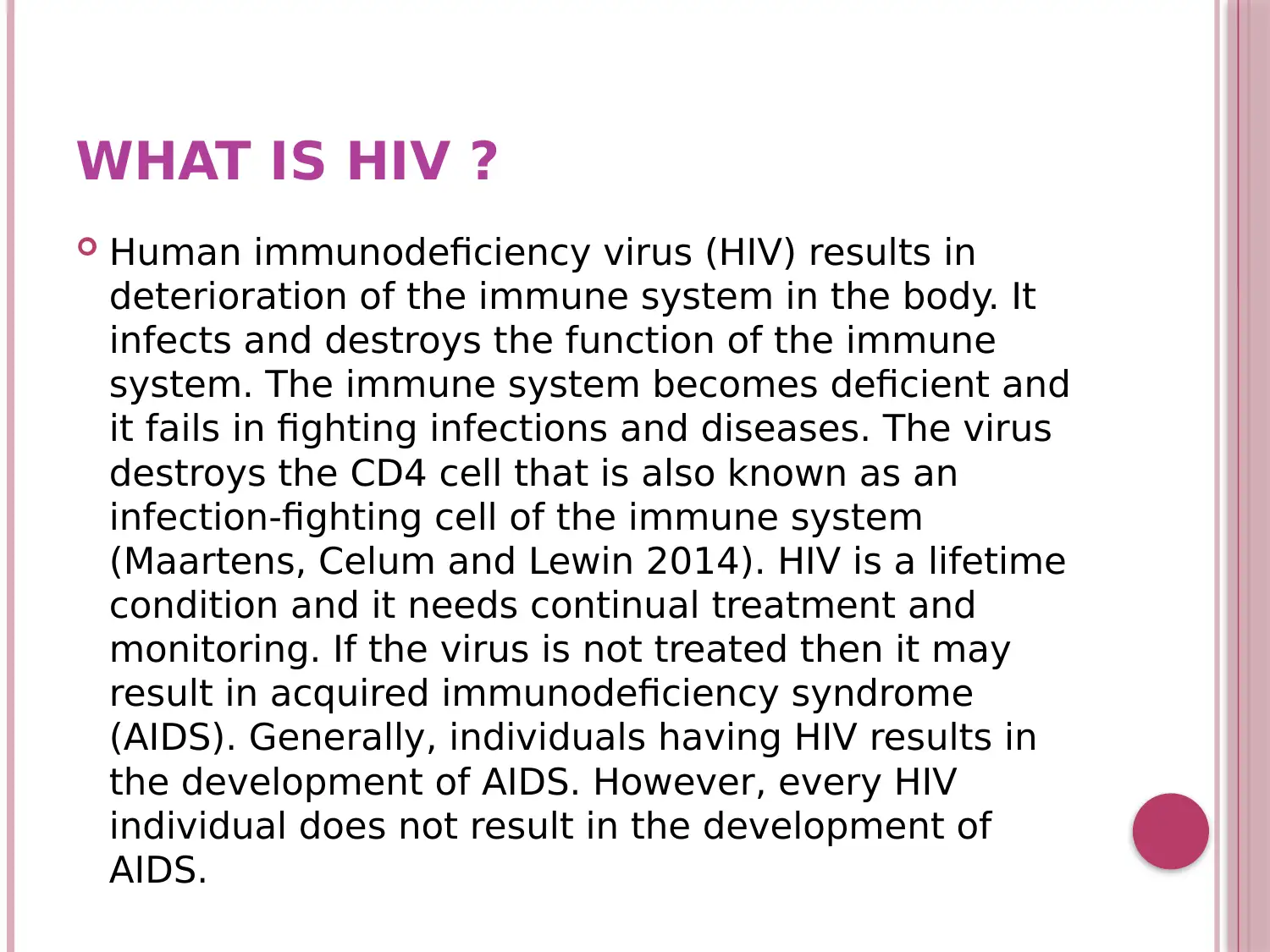
WHAT IS HIV ?
Human immunodeficiency virus (HIV) results in
deterioration of the immune system in the body. It
infects and destroys the function of the immune
system. The immune system becomes deficient and
it fails in fighting infections and diseases. The virus
destroys the CD4 cell that is also known as an
infection-fighting cell of the immune system
(Maartens, Celum and Lewin 2014). HIV is a lifetime
condition and it needs continual treatment and
monitoring. If the virus is not treated then it may
result in acquired immunodeficiency syndrome
(AIDS). Generally, individuals having HIV results in
the development of AIDS. However, every HIV
individual does not result in the development of
AIDS.
Human immunodeficiency virus (HIV) results in
deterioration of the immune system in the body. It
infects and destroys the function of the immune
system. The immune system becomes deficient and
it fails in fighting infections and diseases. The virus
destroys the CD4 cell that is also known as an
infection-fighting cell of the immune system
(Maartens, Celum and Lewin 2014). HIV is a lifetime
condition and it needs continual treatment and
monitoring. If the virus is not treated then it may
result in acquired immunodeficiency syndrome
(AIDS). Generally, individuals having HIV results in
the development of AIDS. However, every HIV
individual does not result in the development of
AIDS.
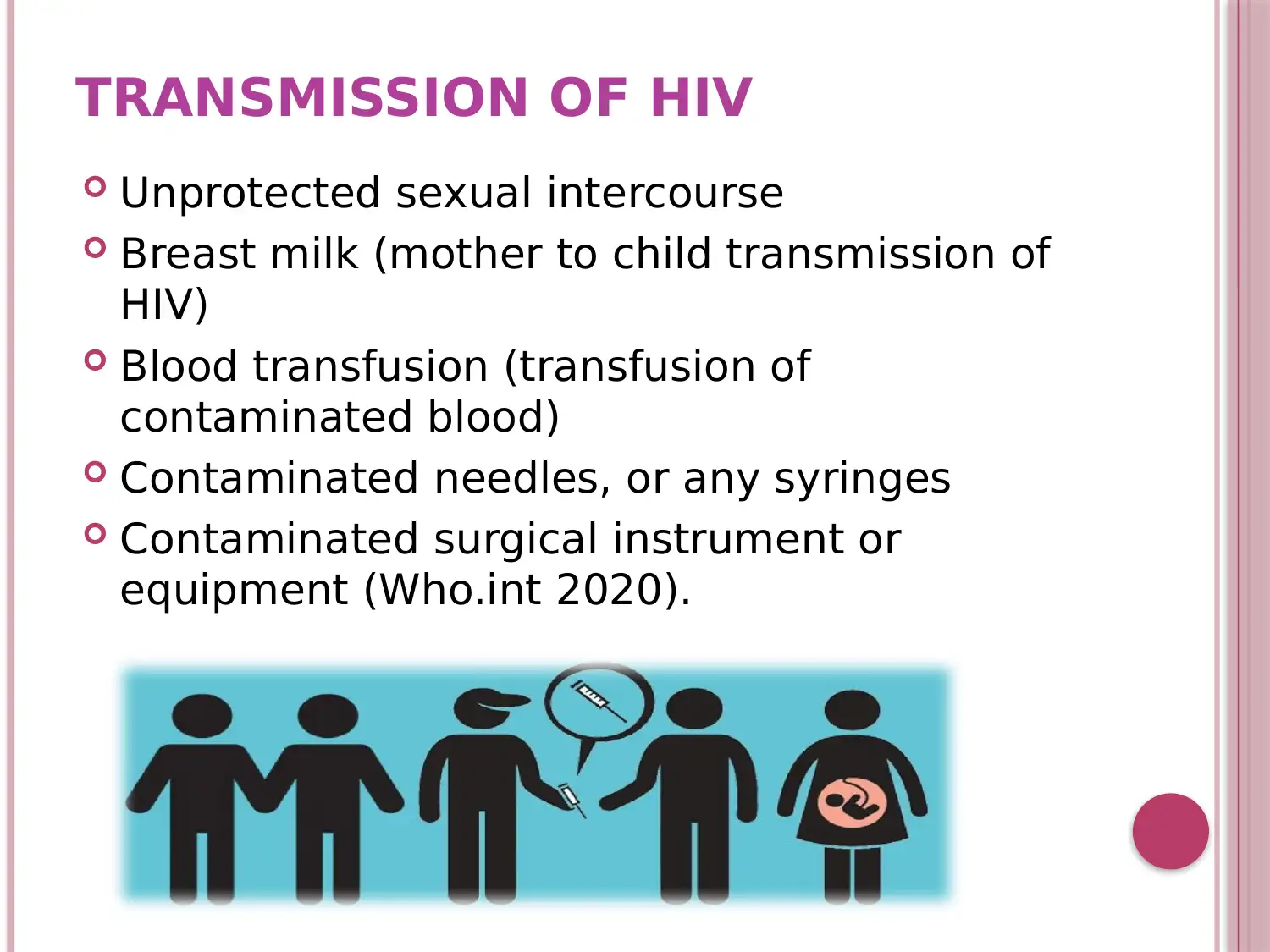
TRANSMISSION OF HIV
Unprotected sexual intercourse
Breast milk (mother to child transmission of
HIV)
Blood transfusion (transfusion of
contaminated blood)
Contaminated needles, or any syringes
Contaminated surgical instrument or
equipment (Who.int 2020).
Unprotected sexual intercourse
Breast milk (mother to child transmission of
HIV)
Blood transfusion (transfusion of
contaminated blood)
Contaminated needles, or any syringes
Contaminated surgical instrument or
equipment (Who.int 2020).
⊘ This is a preview!⊘
Do you want full access?
Subscribe today to unlock all pages.

Trusted by 1+ million students worldwide
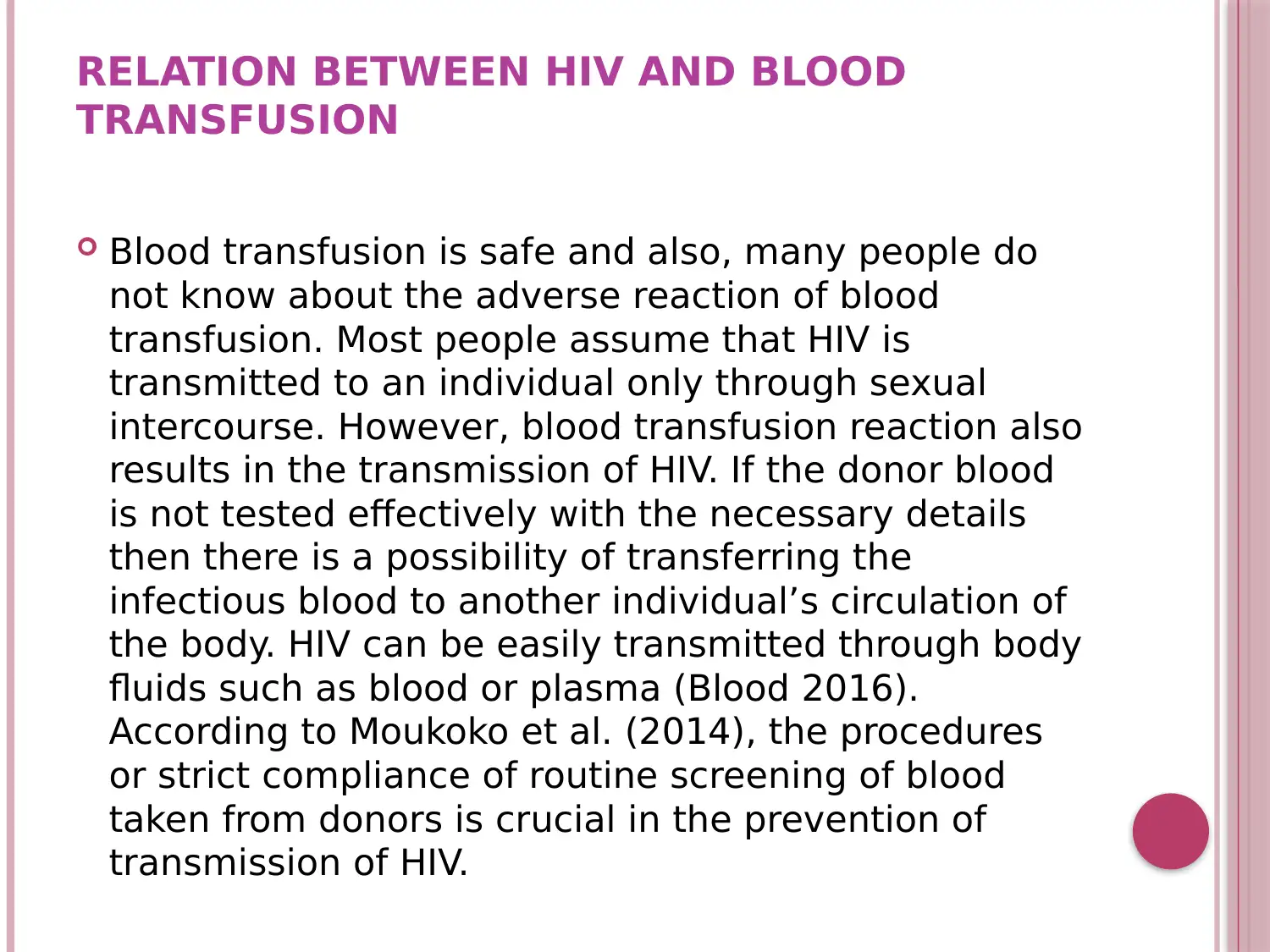
RELATION BETWEEN HIV AND BLOOD
TRANSFUSION
Blood transfusion is safe and also, many people do
not know about the adverse reaction of blood
transfusion. Most people assume that HIV is
transmitted to an individual only through sexual
intercourse. However, blood transfusion reaction also
results in the transmission of HIV. If the donor blood
is not tested effectively with the necessary details
then there is a possibility of transferring the
infectious blood to another individual’s circulation of
the body. HIV can be easily transmitted through body
fluids such as blood or plasma (Blood 2016).
According to Moukoko et al. (2014), the procedures
or strict compliance of routine screening of blood
taken from donors is crucial in the prevention of
transmission of HIV.
TRANSFUSION
Blood transfusion is safe and also, many people do
not know about the adverse reaction of blood
transfusion. Most people assume that HIV is
transmitted to an individual only through sexual
intercourse. However, blood transfusion reaction also
results in the transmission of HIV. If the donor blood
is not tested effectively with the necessary details
then there is a possibility of transferring the
infectious blood to another individual’s circulation of
the body. HIV can be easily transmitted through body
fluids such as blood or plasma (Blood 2016).
According to Moukoko et al. (2014), the procedures
or strict compliance of routine screening of blood
taken from donors is crucial in the prevention of
transmission of HIV.
Paraphrase This Document
Need a fresh take? Get an instant paraphrase of this document with our AI Paraphraser
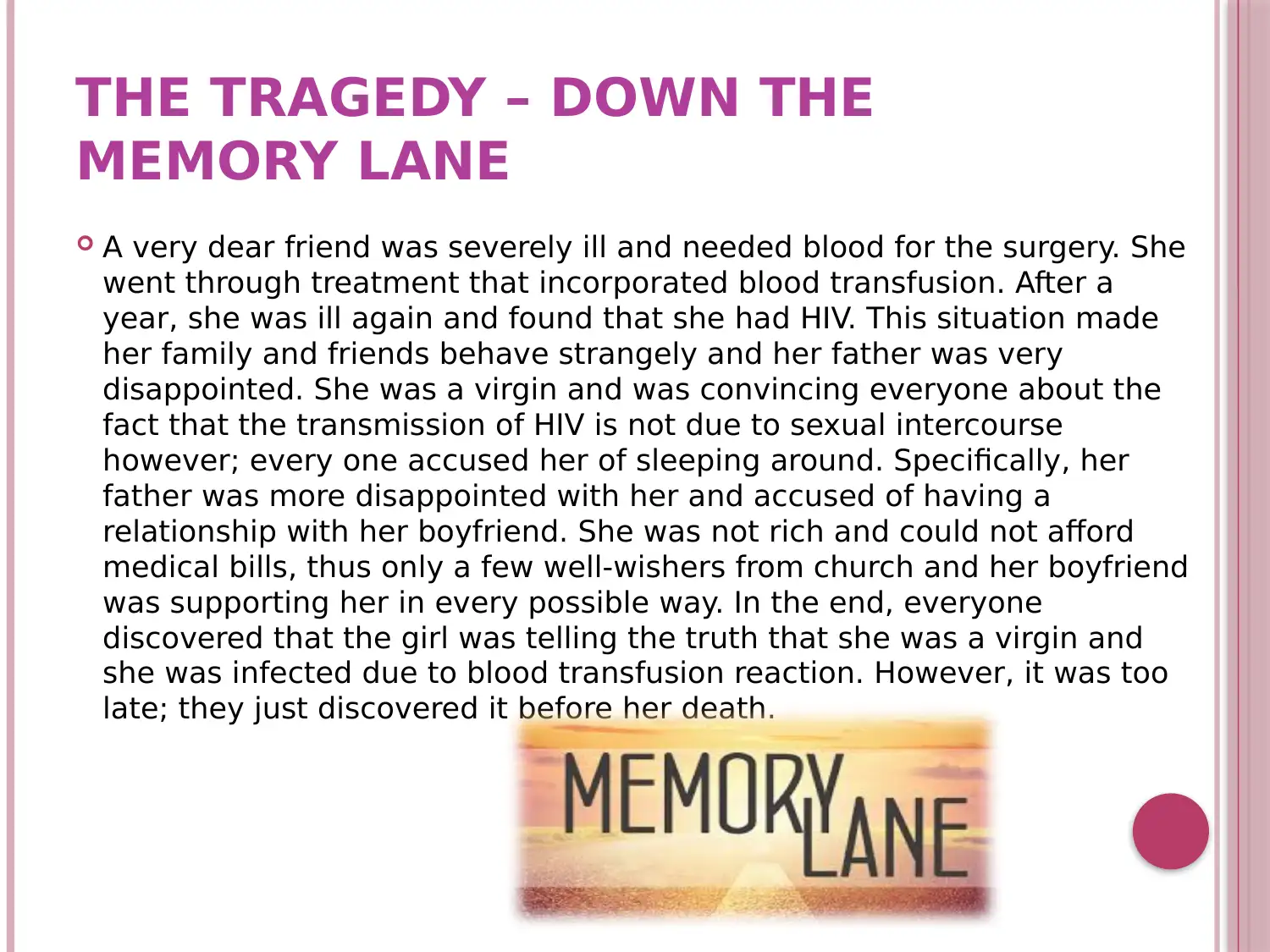
THE TRAGEDY – DOWN THE
MEMORY LANE
A very dear friend was severely ill and needed blood for the surgery. She
went through treatment that incorporated blood transfusion. After a
year, she was ill again and found that she had HIV. This situation made
her family and friends behave strangely and her father was very
disappointed. She was a virgin and was convincing everyone about the
fact that the transmission of HIV is not due to sexual intercourse
however; every one accused her of sleeping around. Specifically, her
father was more disappointed with her and accused of having a
relationship with her boyfriend. She was not rich and could not afford
medical bills, thus only a few well-wishers from church and her boyfriend
was supporting her in every possible way. In the end, everyone
discovered that the girl was telling the truth that she was a virgin and
she was infected due to blood transfusion reaction. However, it was too
late; they just discovered it before her death.
MEMORY LANE
A very dear friend was severely ill and needed blood for the surgery. She
went through treatment that incorporated blood transfusion. After a
year, she was ill again and found that she had HIV. This situation made
her family and friends behave strangely and her father was very
disappointed. She was a virgin and was convincing everyone about the
fact that the transmission of HIV is not due to sexual intercourse
however; every one accused her of sleeping around. Specifically, her
father was more disappointed with her and accused of having a
relationship with her boyfriend. She was not rich and could not afford
medical bills, thus only a few well-wishers from church and her boyfriend
was supporting her in every possible way. In the end, everyone
discovered that the girl was telling the truth that she was a virgin and
she was infected due to blood transfusion reaction. However, it was too
late; they just discovered it before her death.
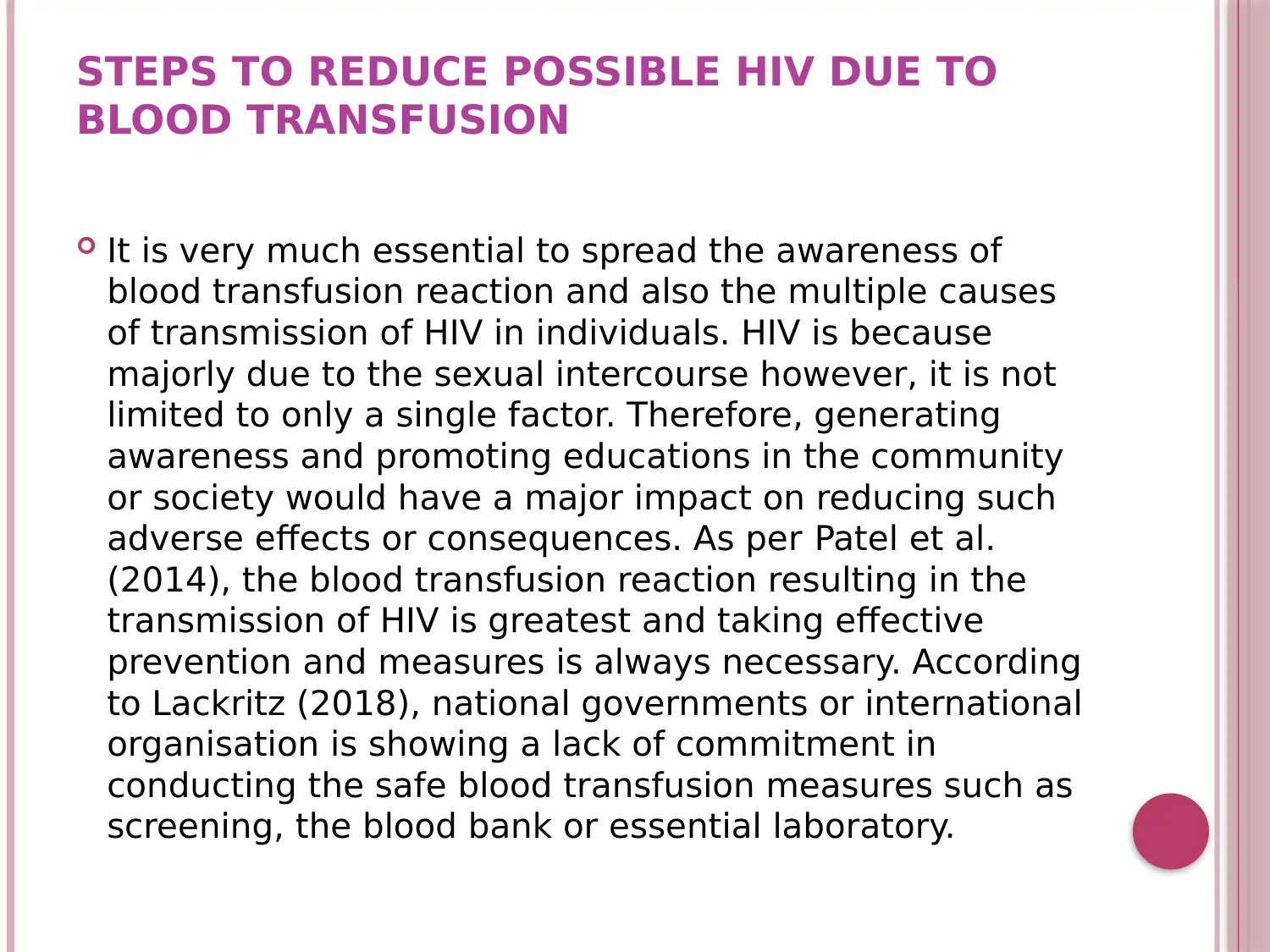
STEPS TO REDUCE POSSIBLE HIV DUE TO
BLOOD TRANSFUSION
It is very much essential to spread the awareness of
blood transfusion reaction and also the multiple causes
of transmission of HIV in individuals. HIV is because
majorly due to the sexual intercourse however, it is not
limited to only a single factor. Therefore, generating
awareness and promoting educations in the community
or society would have a major impact on reducing such
adverse effects or consequences. As per Patel et al.
(2014), the blood transfusion reaction resulting in the
transmission of HIV is greatest and taking effective
prevention and measures is always necessary. According
to Lackritz (2018), national governments or international
organisation is showing a lack of commitment in
conducting the safe blood transfusion measures such as
screening, the blood bank or essential laboratory.
BLOOD TRANSFUSION
It is very much essential to spread the awareness of
blood transfusion reaction and also the multiple causes
of transmission of HIV in individuals. HIV is because
majorly due to the sexual intercourse however, it is not
limited to only a single factor. Therefore, generating
awareness and promoting educations in the community
or society would have a major impact on reducing such
adverse effects or consequences. As per Patel et al.
(2014), the blood transfusion reaction resulting in the
transmission of HIV is greatest and taking effective
prevention and measures is always necessary. According
to Lackritz (2018), national governments or international
organisation is showing a lack of commitment in
conducting the safe blood transfusion measures such as
screening, the blood bank or essential laboratory.
⊘ This is a preview!⊘
Do you want full access?
Subscribe today to unlock all pages.

Trusted by 1+ million students worldwide
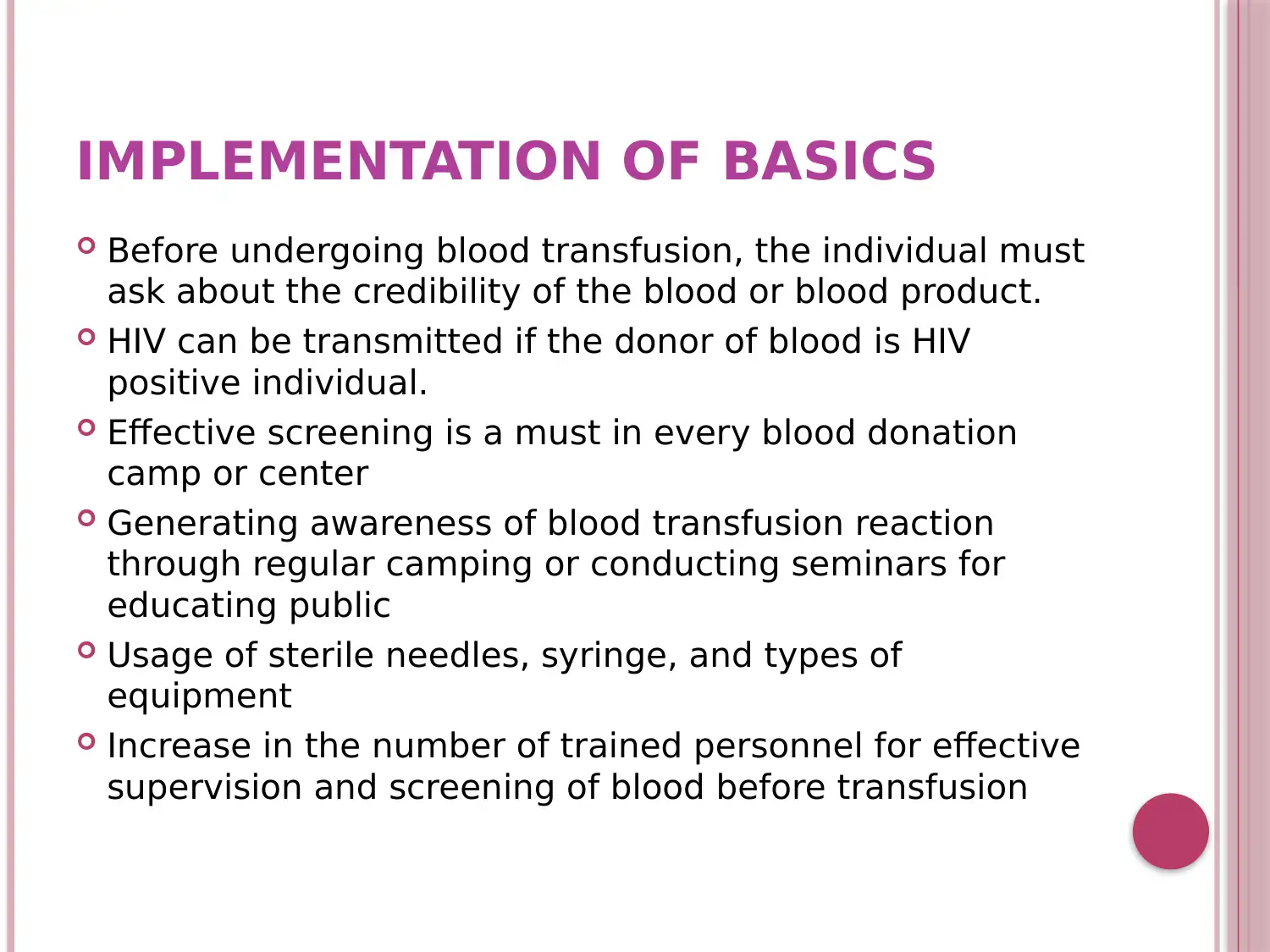
IMPLEMENTATION OF BASICS
Before undergoing blood transfusion, the individual must
ask about the credibility of the blood or blood product.
HIV can be transmitted if the donor of blood is HIV
positive individual.
Effective screening is a must in every blood donation
camp or center
Generating awareness of blood transfusion reaction
through regular camping or conducting seminars for
educating public
Usage of sterile needles, syringe, and types of
equipment
Increase in the number of trained personnel for effective
supervision and screening of blood before transfusion
Before undergoing blood transfusion, the individual must
ask about the credibility of the blood or blood product.
HIV can be transmitted if the donor of blood is HIV
positive individual.
Effective screening is a must in every blood donation
camp or center
Generating awareness of blood transfusion reaction
through regular camping or conducting seminars for
educating public
Usage of sterile needles, syringe, and types of
equipment
Increase in the number of trained personnel for effective
supervision and screening of blood before transfusion
Paraphrase This Document
Need a fresh take? Get an instant paraphrase of this document with our AI Paraphraser
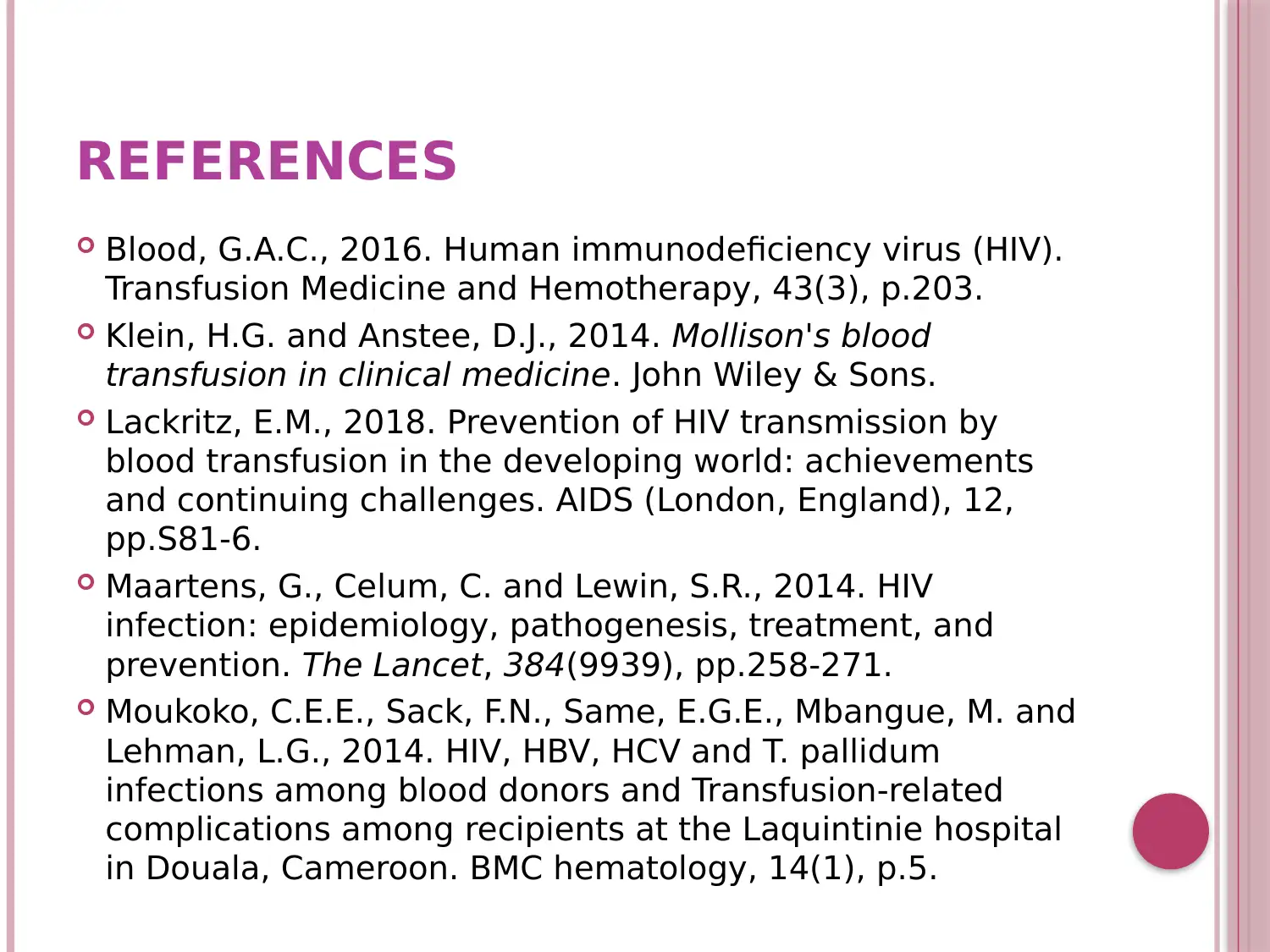
REFERENCES
Blood, G.A.C., 2016. Human immunodeficiency virus (HIV).
Transfusion Medicine and Hemotherapy, 43(3), p.203.
Klein, H.G. and Anstee, D.J., 2014. Mollison's blood
transfusion in clinical medicine. John Wiley & Sons.
Lackritz, E.M., 2018. Prevention of HIV transmission by
blood transfusion in the developing world: achievements
and continuing challenges. AIDS (London, England), 12,
pp.S81-6.
Maartens, G., Celum, C. and Lewin, S.R., 2014. HIV
infection: epidemiology, pathogenesis, treatment, and
prevention. The Lancet, 384(9939), pp.258-271.
Moukoko, C.E.E., Sack, F.N., Same, E.G.E., Mbangue, M. and
Lehman, L.G., 2014. HIV, HBV, HCV and T. pallidum
infections among blood donors and Transfusion-related
complications among recipients at the Laquintinie hospital
in Douala, Cameroon. BMC hematology, 14(1), p.5.
Blood, G.A.C., 2016. Human immunodeficiency virus (HIV).
Transfusion Medicine and Hemotherapy, 43(3), p.203.
Klein, H.G. and Anstee, D.J., 2014. Mollison's blood
transfusion in clinical medicine. John Wiley & Sons.
Lackritz, E.M., 2018. Prevention of HIV transmission by
blood transfusion in the developing world: achievements
and continuing challenges. AIDS (London, England), 12,
pp.S81-6.
Maartens, G., Celum, C. and Lewin, S.R., 2014. HIV
infection: epidemiology, pathogenesis, treatment, and
prevention. The Lancet, 384(9939), pp.258-271.
Moukoko, C.E.E., Sack, F.N., Same, E.G.E., Mbangue, M. and
Lehman, L.G., 2014. HIV, HBV, HCV and T. pallidum
infections among blood donors and Transfusion-related
complications among recipients at the Laquintinie hospital
in Douala, Cameroon. BMC hematology, 14(1), p.5.
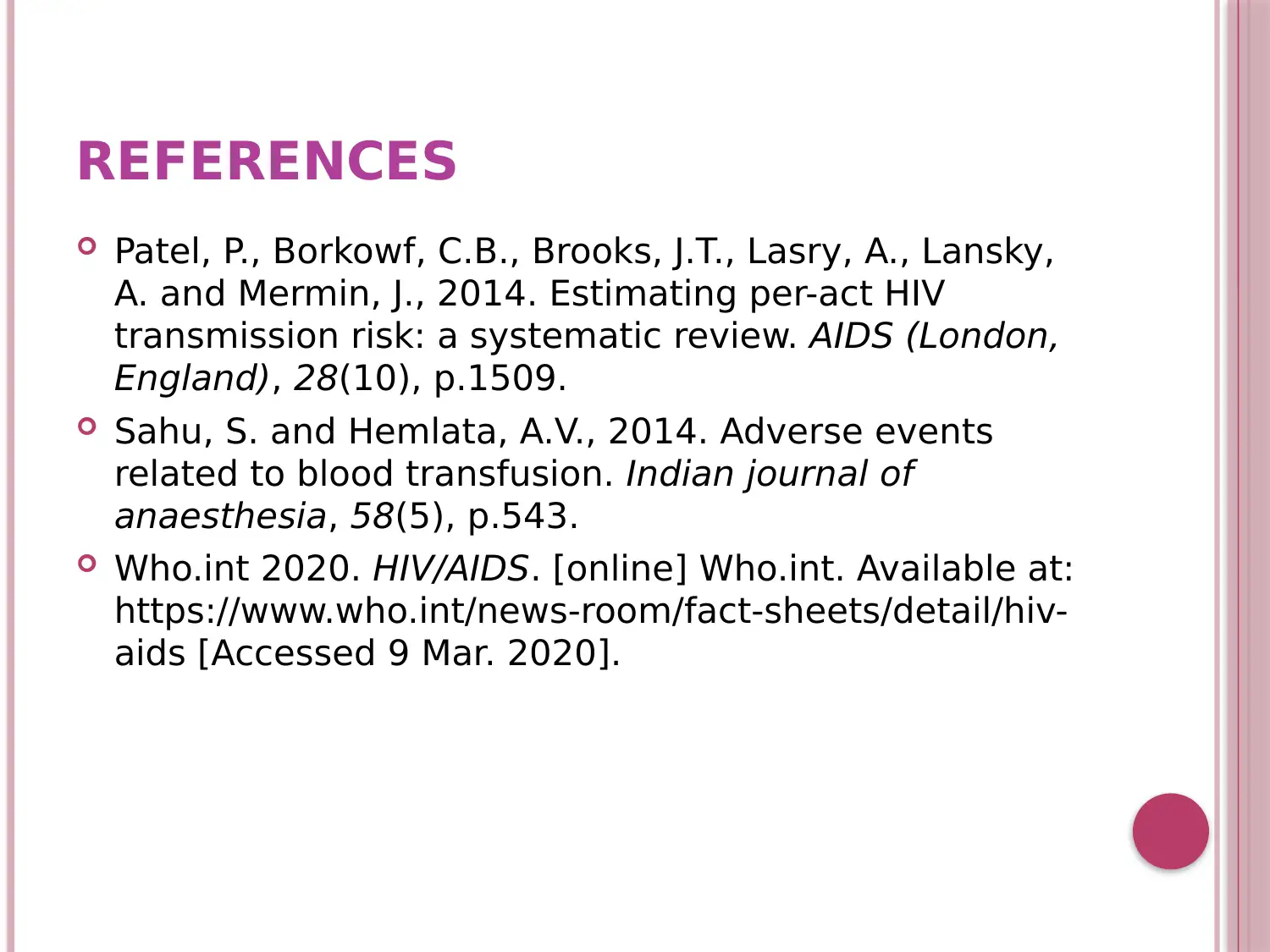
REFERENCES
Patel, P., Borkowf, C.B., Brooks, J.T., Lasry, A., Lansky,
A. and Mermin, J., 2014. Estimating per-act HIV
transmission risk: a systematic review. AIDS (London,
England), 28(10), p.1509.
Sahu, S. and Hemlata, A.V., 2014. Adverse events
related to blood transfusion. Indian journal of
anaesthesia, 58(5), p.543.
Who.int 2020. HIV/AIDS. [online] Who.int. Available at:
https://www.who.int/news-room/fact-sheets/detail/hiv-
aids [Accessed 9 Mar. 2020].
Patel, P., Borkowf, C.B., Brooks, J.T., Lasry, A., Lansky,
A. and Mermin, J., 2014. Estimating per-act HIV
transmission risk: a systematic review. AIDS (London,
England), 28(10), p.1509.
Sahu, S. and Hemlata, A.V., 2014. Adverse events
related to blood transfusion. Indian journal of
anaesthesia, 58(5), p.543.
Who.int 2020. HIV/AIDS. [online] Who.int. Available at:
https://www.who.int/news-room/fact-sheets/detail/hiv-
aids [Accessed 9 Mar. 2020].
⊘ This is a preview!⊘
Do you want full access?
Subscribe today to unlock all pages.

Trusted by 1+ million students worldwide
1 out of 13
Related Documents
Your All-in-One AI-Powered Toolkit for Academic Success.
+13062052269
info@desklib.com
Available 24*7 on WhatsApp / Email
![[object Object]](/_next/static/media/star-bottom.7253800d.svg)
Unlock your academic potential
Copyright © 2020–2025 A2Z Services. All Rights Reserved. Developed and managed by ZUCOL.





